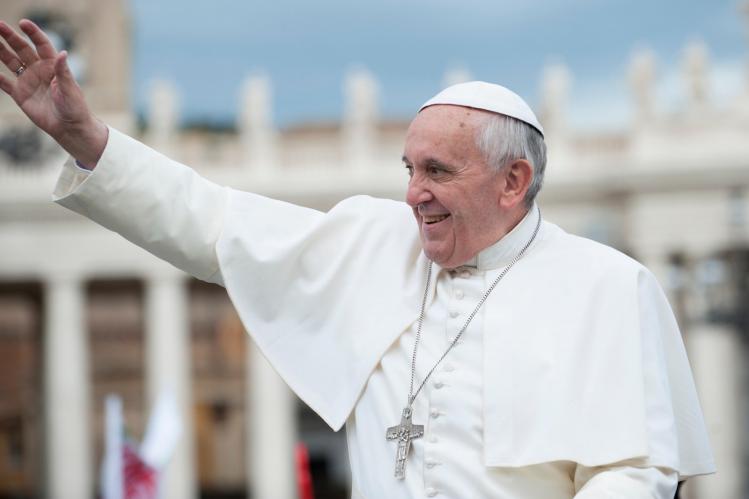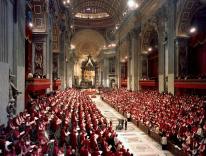
The following essay is adapted from the pope’s preface to Fraternità—segno dei tempi: il magistero sociale di Papa Francesco by Cardinal Michael Czerny and Fr. Christian Barone, which will be published in Italy by Libreria Editrice Vaticana on September 30. The English-language version, Siblings All, Sign of the Times: The Social Teaching of Pope Francis, will be published by Orbis Books in 2022.
The heart of the Gospel is the proclamation of the Reign of God, in the person of Jesus himself, the Emmanuel, God-Is-With-Us. In him, God brings his project of love for humanity to fulfillment, establishing his lordship over creatures and sowing the seed of divine life in human history, transforming it from within.
Certainly the Reign of God should not be identified or confused with some earthly or political achievement. Nor should it be envisioned as a purely interior reality, one that is merely personal and spiritual, or as a promise that concerns only the world to come. Instead, Christian faith lives by a fascinating and compelling “paradox,” a word very dear to the Jesuit theologian Henri de Lubac. It is what Jesus, forever joined with our flesh, is accomplishing here and now, opening us up to God the Father, bringing about an ongoing liberation in our lives, for in him the Reign of God has already drawn near (Mark 1:12–15). At the same time, for as long as we exist in this flesh, God’s reign remains a promise, a deep yearning that we carry within us, a cry that arises from a creation still marred by evil, one that suffers and groans until the day of its full liberation (Romans 8:19–24).
Therefore the Reign announced by Jesus is a living and dynamic reality. It invites us to conversion, asking our faith to emerge from the stasis of an individual religiosity or from its reduction to legalism. It wants our faith to become instead a continuous and restless searching for the Lord and his Word, one that calls us each to cooperate with the work of God in different situations of life and society. In different ways, often anonymous and silent, even in the history of our failures and our woundedness, the Reign of God is coming true in our hearts and in events happening around us. Like a small seed hidden in the earth (Matthew 13:31–32), like a bit of yeast that leavens the dough (Matthew 13:24–30), Jesus brings into our life story the signs of the new life he has come to start, asking us to work together with him in this task of salvation. Every one of us can contribute to realizing the work of the Reign of God on earth, opening up spaces of salvation and liberation, sowing hope, challenging the deadly logics of egoism with the brotherly and sisterly spirit of the Gospel, dedicating ourselves in tenderness and solidarity for the benefit of our neighbors, especially the poorest.
We must never neutralize this social dimension of the Christian faith. As I mentioned also in Evangelii gaudium, the kerygma or proclamation of the Christian faith itself has a social dimension. It invites us to build a society where the logic of the Beatitudes and of a fraternal world of solidarity triumphs. The God Who Is Love, who in Jesus invites us to live out the commandment of sibling love, heals with that same love both our personal and social relationships, calling us to be peacemakers and builders of sisterhood and brotherhood among ourselves:
The Gospel is about the kingdom of God (Luke 4:43); it is about loving God who reigns in our world. To the extent that He reigns within us, the life of society will be a setting for universal fraternity, justice, peace, and dignity. Both Christian preaching and life, then, are meant to have an impact on society (Evangelii gaudium, 180).
In this sense, caring for our Mother Earth and building a society of solidarity as fratelli tutti or siblings all are not only not foreign to our faith; they are a concrete realization of it.
This is the foundation of the Church’s social teaching. It’s not just a simple social extension of Christian faith, but a reality with a theological grounding: God’s love for humanity and his plan of love—and of sisterhood and brotherhood—that he accomplishes in human history through Jesus Christ his son, to whom all believers are intimately united through the Holy Spirit.
I’m grateful to Cardinal Michael Czerny and Fr. Christian Barone, brothers in faith, for their contribution on the subject of brother- and sister-hood. I’m also grateful that this book, while intended as a guide to the encyclical Fratelli tutti, endeavors to bring to light and make explicit the profound link between the Church’s current social teaching and the teachings of the Second Vatican Council.
This link is not always noticed, at least not at first. I’ll try to explain why. The ecclesial climate of Latin America, in which I was immersed first as a young Jesuit student and then in ministry, had enthusiastically absorbed and taken possession of the theological, ecclesial, and spiritual intuitions of the Council, actualizing and enculturating them. For the youngest among us, the Council became the horizon of our belief, and of our ways of speaking and acting. That is, it quickly became our ecclesial and pastoral ecosystem. But we didn’t get into the habit of reciting conciliar decrees, nor did we linger on speculative reflections. The Council had simply entered our way of being Christian and our way of “being Church”—and as life went on, my intuitions, my perceptions, and my spirituality were quite simply born out of the suggestions from the teachings of Vatican II. There wasn’t much need to quote the Council’s documents.
Today, after many decades, we find ourselves in a world—and in a Church—deeply changed, and it’s probably necessary to make more explicit the Second Vatican Council’s key concepts, its theological and pastoral horizon, its topics, and its methods.
In the first part of their valuable book, Cardinal Michael and Fr. Christian help us with this. They read and interpret the social teaching I am trying to carry out, bringing to light something a little hidden between the lines—that is, the teaching of the Council as the fundamental basis, and point of departure for the invitation I’m making to the Church and the whole world with this ideal of brotherhood and sisterhood. It’s one of the signs of the times that Vatican II brings to light, and the thing that our world—our common home, in which we’re called to live as siblings—most needs.
In this connection, their new book also has the merit of rereading, in today’s world, the Council’s intuition of an open Church in dialogue with the world. In the face of the questions and challenges of the modern world, Vatican II tried to respond with the breath of Gaudium et spes; but today as we follow the path marked out by the Council Fathers, we realize that there’s a need not only for the Church to be in dialogue with the modern world, but, most of all, for it to put itself at the service of humanity, taking care of creation as well as announcing and working to realize a new universal sisterhood and brotherhood, in which human relations are healed of egoism and violence and are founded instead on reciprocal love, welcome, and solidarity.
If this is what today’s world is asking of us—especially in a society strongly marked by imbalances, injuries, and injustices—we realize that this, too, is in the spirit of the Council, which invites us to read and listen to the signs of human history. This book also has the merit of offering us a reflection on the methodology of post-conciliar theology—a historical-theological-pastoral methodology, in which human history is the site of God’s revelation. Here theology develops its orientation through reflection, and pastoral ministry incarnates theology in ecclesial and social praxis. This is why papal teachings always need to be attentive to history, and why they require the contributions of theology.
Finally, this collaboration between a cardinal and a young theologian is itself an example of how study, reflection, and ecclesial experience can be joined, and it also indicates a new method: an official voice and a young voice, together. That’s how we should always journey: the magisterium, theology, pastoral praxis, official leadership. Always together. Our bonds will be more credible if in the Church we too begin to feel like we are siblings all, fratelli tutti, and to live our respective ministries as a service to the Gospel, the building up of the Reign of God, and the care of our common home.
Translated by Griffin Oleynick

